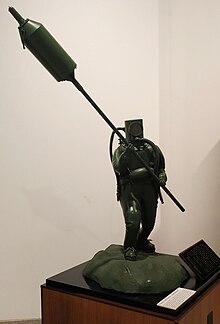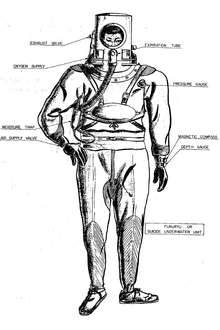Fukuryu
The Fukuryū ( Japanese 伏 竜 , dt. "Hidden Dragon") were a unit of combat divers of the Imperial Japanese Navy , which was set up towards the end of the Pacific War in World War II . They were supposed to lurk on the sea floor in shallow waters near the coast and ram enemy landing craft passing over them in self-sacrifice from below with an explosive charge, which was equipped with a percussion fuse , and thus sink them.
prehistory
When the Allied superiority in the Pacific became ever greater from mid-1944 and the Japanese capital ship units were gradually smashed, various departments of the Navy began to further develop the previously neglected concept of small arms in order to be able to fend off a possible Allied invasion of Japan at low cost. In this context, a plan was developed at a submarine defense school to use divers in coastal waters, which were considered potential landing sites, in order to destroy the landing craft as they crossed this area.
implementation
The plans envisaged the modification of a diving suit, as it had previously been mainly used by work divers. The Fukuryū diver should operate with the suit at depths of 10 to 15 meters and walk in groups along the sea floor until a suitable target is discovered. Then he was to rise and strike a simple explosive device attached to a long pole against the underside of the target's hull. The subsequent explosion should destroy or sink the target, but would also kill the diver as a result of the overpressure created.
Since the diver could only travel around 2 kilometers per hour underwater, he had to be in a favorable position when the enemy began his landing operation. For this purpose, lounges were constructed that should be lowered to the seabed in the operational area.
Diving equipment
The core of the diving equipment was two 35-liter bottles with oxygen as breathing gas , which the "Fukuryū" fighter carried on his back. The oxygen passed through a regulator and was then introduced into the diving helmet , where the diver inhaled it through the nose. The patient exhaled through the mouth into a tube in which the air was first freed of moisture before it reached a chemical air purifier made of sodium hydroxide , from where it was returned to the breathing circuit. The oxygen supply from the tanks could be adjusted by the diver via the valve of the regulator. Each diver wore a dry suit and achieved operating times of up to eight hours.
Every soldier should be given a diving lamp , a depth gauge and a compass on their wrist. In addition, there was a Japanese flag for every man, as it was carried by warships to increase the morale of the fighters.
Armament
Every diver should carry a Type 5 assault mine, which consisted of a 10 kg explosive device on the tip of a pole. The total length of the planned weapon is given as 3.3 meters.
The development of the weapon turned out to be problematic, as the divers had to operate relatively close together in order to be able to work effectively against the landing craft moving in narrow formations. Initially a weapon with 20 kg of explosives was planned, but the developers feared that if such a charge exploded, the excess pressure could kill not only the attacking diver, but also his comrades. It was calculated that the 10 kg load required a minimum distance of 40 meters to the neighboring diver, and the operational distance was set at 60 meters for safety.
In order to facilitate handling, a float was provided below the explosive device so that the mine could be carried without any special effort.
10,000 Type 5 mines were commissioned, but according to post-war investigations, no more operational units were produced by the time Japan surrendered .
organization
The Fukuryū was to have 6,000 soldiers by September 30, 1945, and full operational readiness should be achieved around October 15. The fighters were to be divided into groups of six divers each, five groups formed a platoon, five platoons a company. Three companies formed a battalion. Each platoon also had a commander and three detectors.
Four larger associations were planned:
- 71. Arashi - Yokosuka with 4,000 divers
- 81. Arashi - Kure with 1,000 divers
- Kawatana unit - Sasebo with 1,000 divers
- Maizuru Unit - Ichihara with 500 divers
By the end of the war, 4,000 men had already moved together in Yokosuka, but only 1,200 of them had completed their training.
Resource planning
The prepared deployment plan provided for several lines of defense in front of a threatened stretch of beach:
- The first line should consist of sea mines at a depth of 10 to 15 meters, which should be anchored to the bottom and triggered by the Fukuryū from a safe distance with a pull rope. They then floated to the surface and exploded on contact with a landing craft.
- Then followed three lines of Fukuryū with Type 5 mines. The rows were about 50 meters apart, with 60 meters between the fighters in each row. The rows were staggered so that a diver stood at intervals of 20 meters. You should operate at depths between 10 and 6 meters.
- Further towards the beach, at a depth of 3 meters, a number of magnetic mines should be laid.
- The last line should be land mines, which should be laid at depths of up to one meter.
Accommodations
In order to be on the scene quickly, shelters anchored on the seabed were planned for 6 to 18 soldiers each. In order not to endanger the element of surprise, they should be as inconspicuous as possible. It was planned to build reinforced concrete structures with a lock and a living area. They should not be sunk to a depth of more than 15 meters and should be shaped differently to make discovery more difficult.
In the entrance to Tokyo Bay it was planned to sink shipwrecks, in which a built-in lock provided access to a living area and a torpedo launcher. Three torpedo tubes and a listening device were to be installed. 40 to 50 fighters should find space here.
All facilities should have storage facilities for oxygen bottles, water and food.
End of war
The final questioning of the officers of the 71st Arashi , which the Americans carried out at the end of the war, showed no evidence that the planned underwater torpedo positions with their accommodations for the Fukuryū had been completed by the end of the war.
When questioning the lower-ranking base personnel, however, they learned that there was an order to testify wrongly on this matter. Since the planned positions of the positions emerged from the captured planning documents, the Americans searched the seabed in the area with the help of sonar from two warships on December 31, 1945 and January 3, 1946 and found them at 35 ° 6 ' N , 139 ° 43 ′ E four suspicious structures at a depth of almost 55 meters. Since no American diver could be used safely at this depth, but it was feared that the facilities could be used for later actions against the American troops, it was recommended that they be destroyed with heavy depth charges .
It is unknown today whether these facilities were manned with Fukuryū or equipped with torpedoes and whether the sonar echoes actually showed such facilities.
Evidence and references
Remarks
- ↑ The fighter should then mount up to carry out his attack. A break for decompression was only planned from a depth of 15 meters.
- ↑ 55 meters (180 feet) were mentioned in the description, but the marked places on the supplied nautical charts are described as having depths of 30 to 37 meters.
literature
- US Naval Technical Mission to Japan, Report S-91 (N): The Fukuryu Special Harbor Defense and Underwater Attack Unit Tokyo Bay.
- Robin L. Rielly: Kamikaze Attacks of World War II. A Complete History of Japanese Suicide Strikes on American Ships, by Aircraft and Other Means. McFarland, Jefferson NC et al. 2010, ISBN 978-0-7864-4654-4 .
Web links
Individual evidence
- ↑ USNTMJ S-91 (N), p. 7.
- ↑ Private website, Japanese, viewed February 20, 2011

